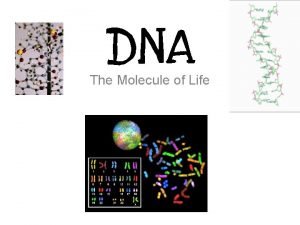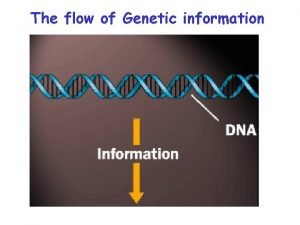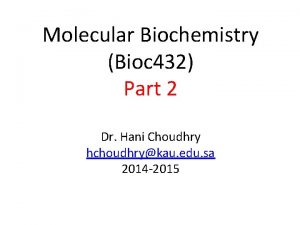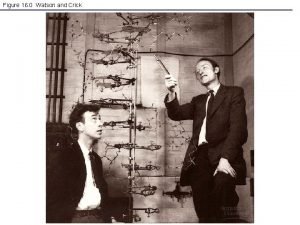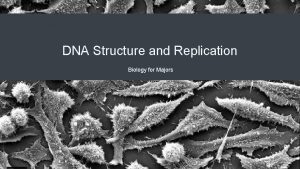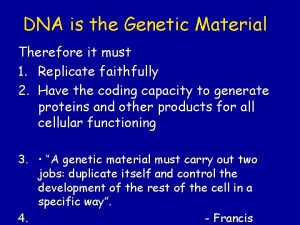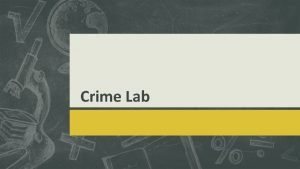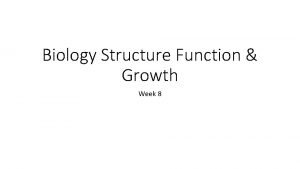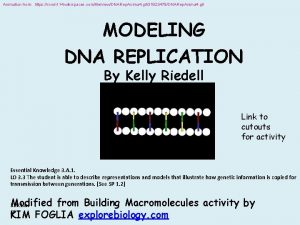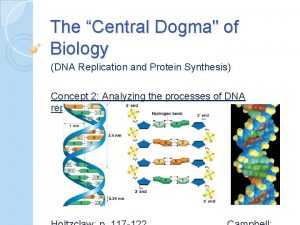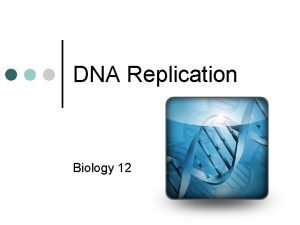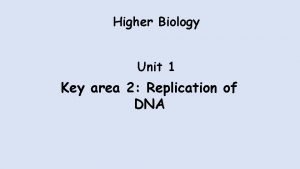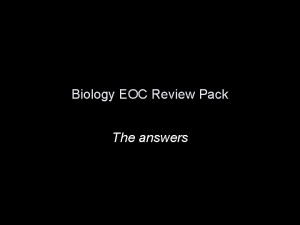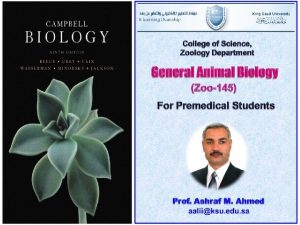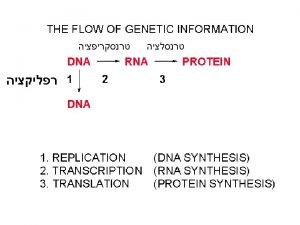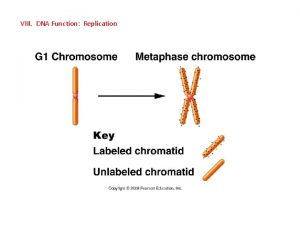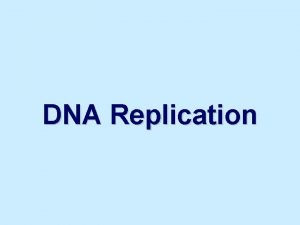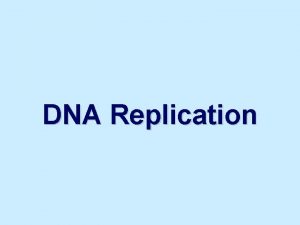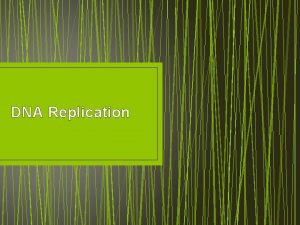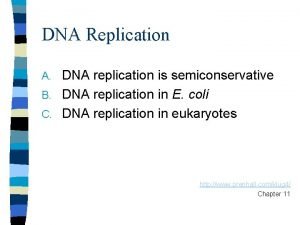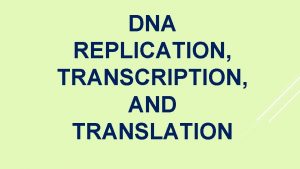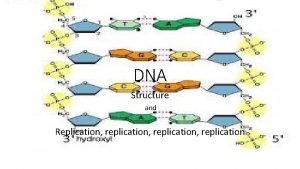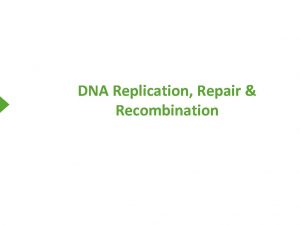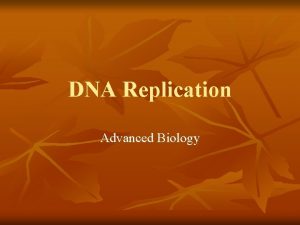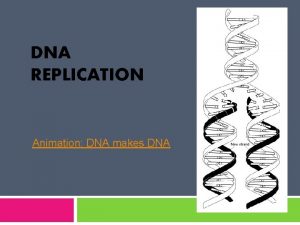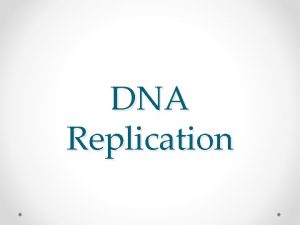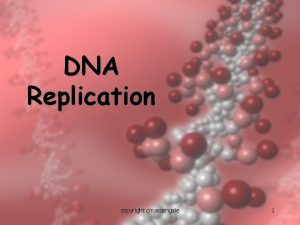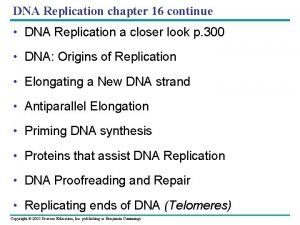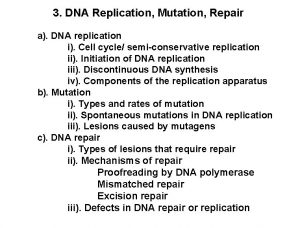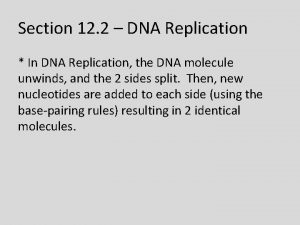VIII DNA Function Replication VIII DNA Function Replication
























- Slides: 24

VIII. DNA Function: Replication

VIII. DNA Function: Replication A. Recap - occurs in the S-phase of Interphase - unreplicated chromosomes, each consisting of a complementary doublehelix, is REPLICATED: produce a chromosomes with 2 identical chromatids. - Once DNA replication has occurred, cells will proceed to division.

VIII. DNA Function: Replication A. Recap - occurs in the S-phase of Interphase - unreplicated chromosomes, each consisting of a complementary doublehelix, is REPLICATED: produce a chromosomes with 2 identical chromatids. - Once DNA replication has occurred, cells will proceed to division. B. Hypotheses:

VIII. DNA Function: Replication A. Recap - occurs in the S-phase of Interphase - unreplicated chromosomes, each consisting of a complementary doublehelix, is REPLICATED: produce a chromosomes with 2 identical chromatids. - Once DNA replication has occurred, cells will proceed to division. B. Hypotheses: 1. Conservative Model: The original DNA is used as a template for the formation of new strand, and then they reanneal: Original DNA new strand formation Reannealing of original strands and synthesis of new double helix.

VIII. DNA Function: Replication A. Recap - occurs in the S-phase of Interphase - unreplicated chromosomes, each consisting of a complementary doublehelix, is REPLICATED: produce a chromosomes with 2 identical chromatids. - Once DNA replication has occurred, cells will proceed to division. B. Hypotheses: 1. Conservative Model: The original DNA is used as a template for the formation of new strand, and then they reanneal : Original DNA new strand formation Reannealing of original strands and synthesis of new double helix.

VIII. DNA Function: Replication A. Recap - occurs in the S-phase of Interphase - unreplicated chromosomes, each consisting of a complementary doublehelix, is REPLICATED: produce a chromosomes with 2 identical chromatids. - Once DNA replication has occurred, cells will proceed to division. B. Hypotheses: 1. Conservative Model: The original DNA is used as a template for the formation of new strand, and then they reanneal : Original DNA new strand formation Reannealing of original strands and synthesis of new double helix.

VIII. DNA Function: Replication A. Recap - occurs in the S-phase of Interphase - unreplicated chromosomes, each consisting of a complementary doublehelix, is REPLICATED: produce a chromosomes with 2 identical chromatids. - Once DNA replication has occurred, cells will proceed to division. B. Hypotheses: 1. Conservative Model: 2. Semi-conservative Model: The original DNA is used as a template for the formation of new strand, which then bind together: Original DNA new strand formation Binding of old and new strands

VIII. DNA Function: Replication A. Recap - occurs in the S-phase of Interphase - unreplicated chromosomes, each consisting of a complementary doublehelix, is REPLICATED: produce a chromosomes with 2 identical chromatids. - Once DNA replication has occurred, cells will proceed to division. B. Hypotheses: 1. Conservative Model: 2. Semi-conservative Model: The original DNA is used as a template for the formation of new strand, which then bind together: Original DNA new strand formation Binding of old and new strands

VIII. DNA Function: Replication A. Recap - occurs in the S-phase of Interphase - unreplicated chromosomes, each consisting of a complementary doublehelix, is REPLICATED: produce a chromosomes with 2 identical chromatids. - Once DNA replication has occurred, cells will proceed to division. B. Hypotheses: 1. Conservative Model: 2. Semi-conservative Model: The original DNA is used as a template for the formation of new strand, which then bind together: Original DNA new strand formation Binding of old and new strands

VIII. DNA Function: Replication A. Recap - occurs in the S-phase of Interphase - unreplicated chromosomes, each consisting of a complementary doublehelix, is REPLICATED: produce a chromosomes with 2 identical chromatids. - Once DNA replication has occurred, cells will proceed to division. B. Hypotheses: 1. Conservative Model: 2. Semi-conservative Model: 3. Dispersive: Old and new DNA distributed throughout double-helix Original DNA new strand formation Dispersal of old and new DNA throughout both chromatids

VIII. DNA Function: Replication A. Recap - occurs in the S-phase of Interphase - unreplicated chromosomes, each consisting of a complementary doublehelix, is REPLICATED: produce a chromosomes with 2 identical chromatids. - Once DNA replication has occurred, cells will proceed to division. B. Hypotheses: 1. Conservative Model: 2. Semi-conservative Model: 3. Dispersive: Old and new DNA distributed throughout double-helix Original DNA new strand formation Dispersal of old and new DNA throughout both chromatids

VIII. DNA Function: Replication A. Recap - occurs in the S-phase of Interphase - unreplicated chromosomes, each consisting of a complementary doublehelix, is REPLICATED: produce a chromosomes with 2 identical chromatids. - Once DNA replication has occurred, cells will proceed to division. B. Hypotheses: 1. Conservative Model: 2. Semi-conservative Model: 3. Dispersive: Old and new DNA distributed throughout double-helix Original DNA new strand formation Dispersal of old and new DNA throughout both chromatids

VIII. DNA Function: Replication A. Recap B. Hypotheses C. The Meselson and Stahl Experiment (1958)

C. The Meselson and Stahl Experiment (1958) - They grew E. coli for many generations on an agar where the available Nitrogen was a heavy isotope. The heavy nitrogen was incorporated into NEW DNA that is synthesized by the cell.

C. The Meselson and Stahl Experiment (1958) - They grew E. coli for many generations on an agar where the available Nitrogen was a heavy isotope. The heavy nitrogen was incorporated into NEW DNA that is synthesized by the cell. When the DNA is spun in a centrifuge, it spins down ‘far’

C. The Meselson and Stahl Experiment (1958) - Then, grew bacteria on an N 15 medium for 1 generation and took samples. What banding pattern would you expect to see under each of the three hypotheses?

C. The Meselson and Stahl Experiment (1958) - Then, grew bacteria on an N 15 medium for 1 generation and took samples. What banding pattern would you expect to see under each of the three hypotheses? - Results refuted the conservative hypothesis.

C. The Meselson and Stahl Experiment (1958) - Then, grew bacteria on an N 15 medium for 1 generation and took samples. What banding pattern would you expect to see under each of the three hypotheses? - Results refuted the conservative hypothesis. - Grew bacteria for a second generation on N 14 medium…. Predictions of 2 models?

C. The Meselson and Stahl Experiment (1958) - Then, grew bacteria on an N 15 medium for 1 generation and took samples. What banding pattern would you expect to see under each of the three hypotheses? - Results refuted the conservative hypothesis. - Grew bacteria for a second generation on N 14 medium…. Predictions of 2 models? - Results refuted the dispersive model and confirmed the semi-conservative model.

D. Replication at the Molecular Level

D. Replication at the Molecular Level 1. Replication in E. coli a. A specific sequence of bases is recognized as the binding site for the replication complex – this is called the Replication Origin, and the DNA replicated from this site is called a replicon.

D. Replication at the Molecular Level 1. Replication in E. coli a. A specific sequence of bases is recognized as the binding site for the replication complex – this is called the Replication Origin, and the DNA replicated from this site is called a replicon. - Bacteria have only a single replication origin, and the entire circular chromosome is replicated from this point.

1. Replication in E. coli a. Replication Origin has 9 -mers and 13 mers – homologous sequences… b. Three enzymes (DNa. A, B, C), collectively called “helicases” bind to the origin and break the hydrogen bonds holding the helices together. “Single-strand binding proteins” stabilize the DNA.

1. Replication in E. coli a. Replication Origin has 9 -mers and 13 mers – homologous sequences… b. Three enzymes (DNa. A, B, C), collectively called “helicases” bind to the origin and break the hydrogen bonds holding the helices together. “Single-strand binding proteins” stabilize the DNA. c. The enzyme gyrase works downstream, cutting single or double strands to relieved the torque on the molecule. (topoisomerases affect shape).
 Bioflix activity dna replication dna replication diagram
Bioflix activity dna replication dna replication diagram Replication fork
Replication fork Dna rna protein synthesis homework #2 dna replication
Dna rna protein synthesis homework #2 dna replication Forms of dna
Forms of dna Dna stand for
Dna stand for 3-5 exonuclease vs 5-3 exonuclease
3-5 exonuclease vs 5-3 exonuclease 5 enzymes responsible for dna replication
5 enzymes responsible for dna replication Polyribosomes
Polyribosomes Multiple choice questions on dna structure and replication
Multiple choice questions on dna structure and replication Major enzymes in dna replication
Major enzymes in dna replication Antiparallel in dna replication
Antiparallel in dna replication Dna replication jeopardy
Dna replication jeopardy Replication fork labeled
Replication fork labeled Dna replication vs pcr
Dna replication vs pcr What is this name
What is this name Nucleoside triphosphate in dna replication
Nucleoside triphosphate in dna replication Bioflix dna replication
Bioflix dna replication Cell analogy restaurant
Cell analogy restaurant Replication origin
Replication origin Dna replication transcription and translation
Dna replication transcription and translation Dna replication higher biology
Dna replication higher biology Why is dna replication considered semiconservative
Why is dna replication considered semiconservative Dna replication pearson
Dna replication pearson Direction of helicase
Direction of helicase Dna replication in bacteria occurs
Dna replication in bacteria occurs




